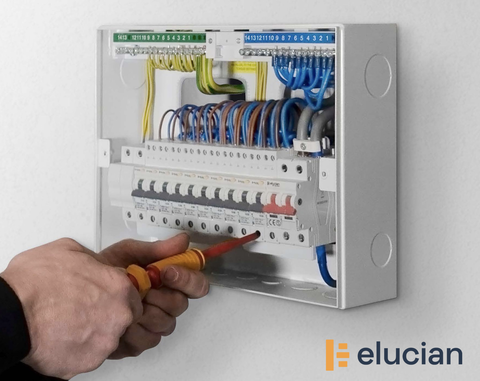If you are replacing a consumer unit for a customer, then you probably have a couple of questions. Luckily Neil McManus, from the Scolmore Group, has the answers! See below a series of questions and answers from the recent webinar, “Things To Consider When Replacing A Consumer Unit”.

Question 1
(A) Diversity of rcbo position
(B) Should ALL circuits be protected by a RCD even where the existing consumer unit supplies some loads from RCD and some from standard circuit-breakers?
Answer
Q1 A: There is no requirement within BS 7671 for RCBOs to be positioned in a particular way. Typical practice is to position the largest rated device next to the main switch and use progressively smaller devices further away. However, this is not a requirement.
B): No. Standards are not retrospective. However, where new circuits are added to an existing installation, those new circuits should conform to the requirements of BS 7671.
Question 2
Does the "traditional" split consumer unit with two RCDs meet the requirements of Amd 2 of BS 7671?
Answer
Yes. However, Regulation 531.3.2 does require devices to be selected and erected such as to limit the risk of unwanted tripping. Furthermore, Regulation 314.1, in part, requires an installation to be subdivided into circuits to minimise inconvenience in the event of a fault.
Question 3
When there is limited space inside a meter cupboard for the consumer unit to be installed horizontally, do the regulations change if fitted in the vertical position to allow for heat dissipation
Answer
Manufacturer’s instruction manuals should always be followed when consideration is being given to the orientation of electrical equipment, such as consumer units.
The Elucian consumer unit hasn’t been product tested for this type of installation and therefore should not be installed in a vertical position.
Question 4
Is it necessary to use glands on consumer units to protect cable entries?
Answer
There is no specific requirement for glands to be used on a consumer unit, and there is no specific requirement for the unit to be ‘fire sealed’.
Regulation 522.8.5 requires every cable or conductor to be supported in such a way that it is not exposed to undue mechanical strain. The note to this requirement explains that meter tails are included within this requirement, and as such, most meter tails are now ‘glanded’ into consumer units.
This requirement is not included to ‘fire seal’ the consumer unit.
Regulation 421.1.201 (within domestic (household) premises) requires consumer units to: (i) have their enclosure manufactured from non-combustible material, or (ii) be enclosed in a cabinet or enclosure constructed of non-combustible material and complying with Regulation 132.12.
Testing carried out on metal-cased consumer units has clearly shown that no special glands or fire stopping of cable entries is required.
The requirements of Regulation group 416.2 for barriers or enclosures must be met and manufacturers’ instructions, if any, should be taken into consideration
Question 5
How do you fit surge protection devices on a split-board?
Answer
SPD - should this be installed before or after the CU main switch disconnector?
Question 6
Is it correct that you don't need an MCB for a type 2 SPD? I thought BS 7671 required overcurrent protection for all SPDs.
Answer
Regulation 534.4.5.1 requires SPD installations to be protected against overcurrent with respect to short-circuit currents.
An SPD may have internal protection and, therefore, this requirement would be met this way. Where there is no internal means of protection and separate means of overcurrent protection would be required
Question 7
When is an SPD to be installed
Answer
Regulation 443.4.1 requires SPDs to be installed under three specific conditions.
Protection against transient overvoltages shall be provided where the consequence caused by the overvoltage could result in:
(i) serious injury to, or loss of, human life
(ii) failure of a safety service, as defined in Part 2
(iii) significant financial or data loss.
For all other cases, protection against transient overvoltages shall be provided unless the owner of the installation declares it is not required due to any loss or damage being tolerable and they accept the risk of damage to equipment and any consequential loss.
Question 8
For a TT Earthing system, are double-pole protective devices required?
Answer
Regulation 531.3.1.201 is clear, there is no requirement to disconnect/switch the neutral in TT or TN systems for protection against electric shock.
Want to learn more about replacing a consumer unit? Then be sure to check out our webinar with Neil McManus and the Scolmore Group “Things To Consider When Replacing A Consumer Unit” available now on demand.
